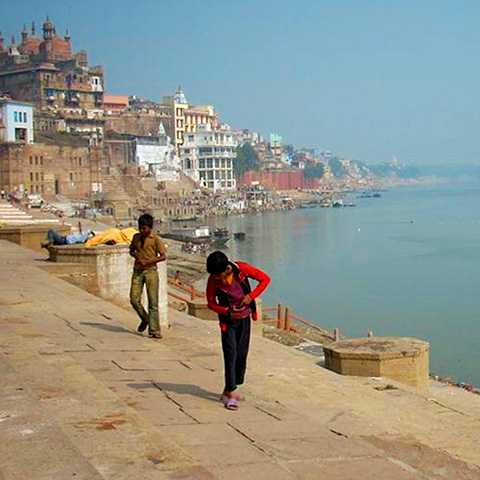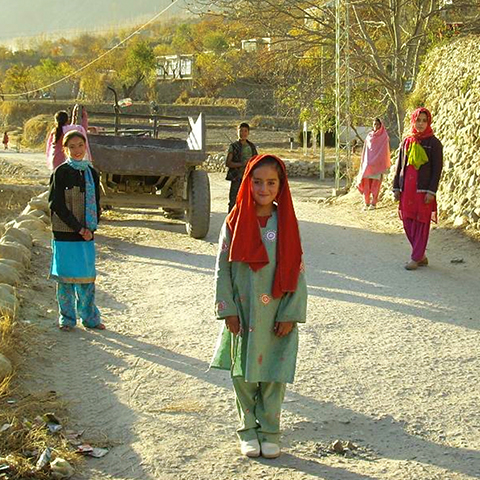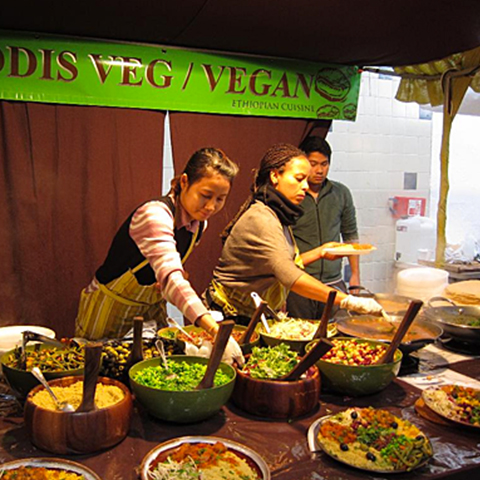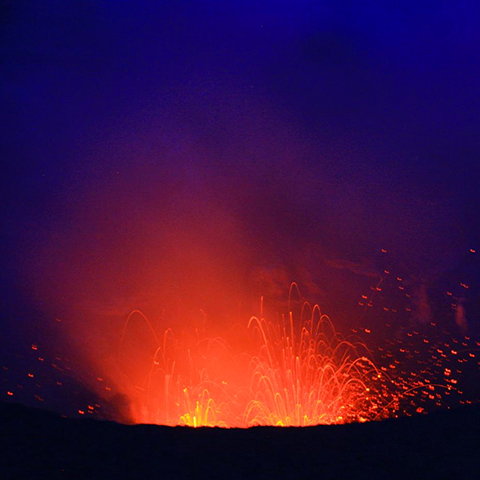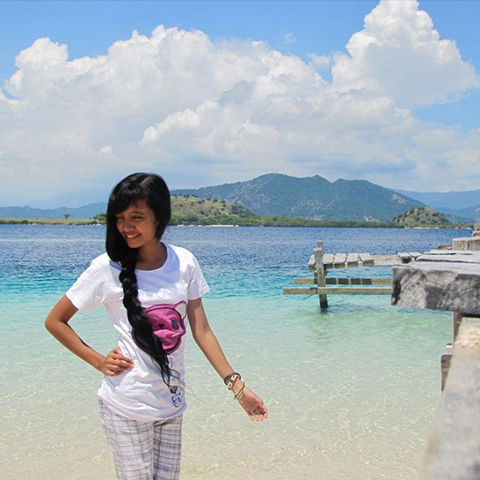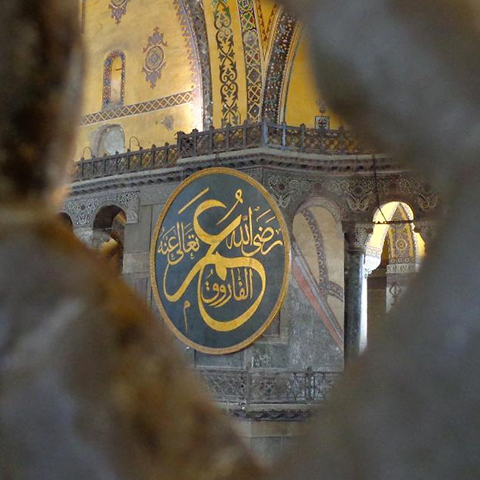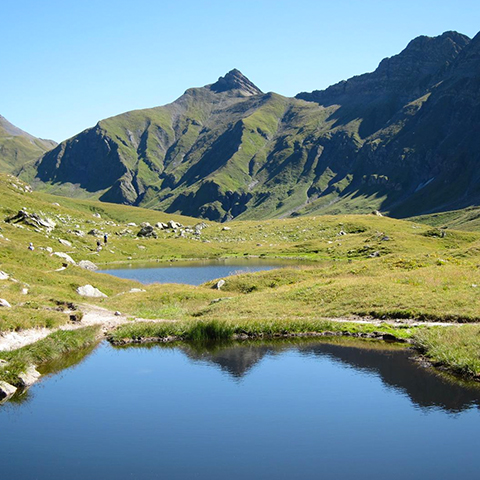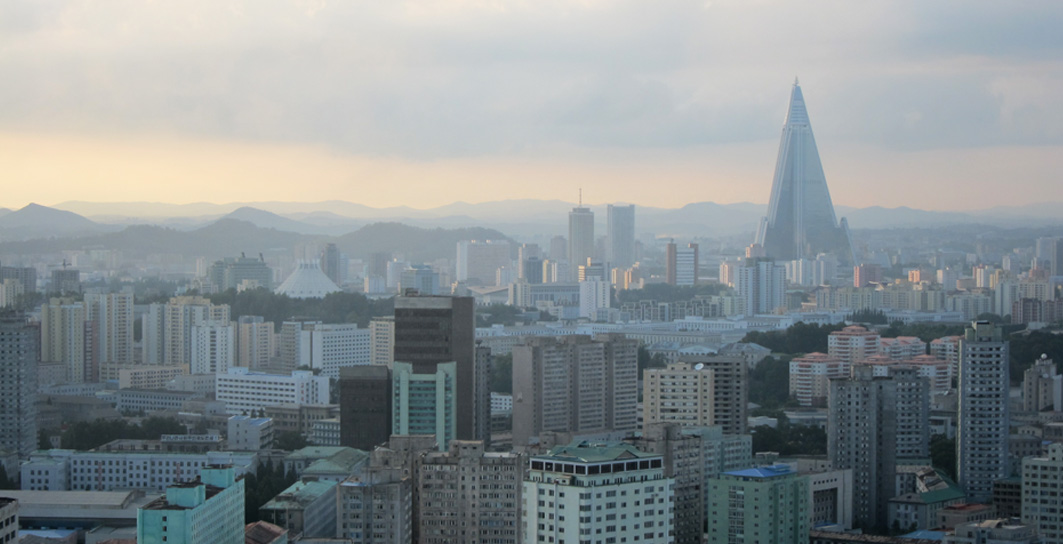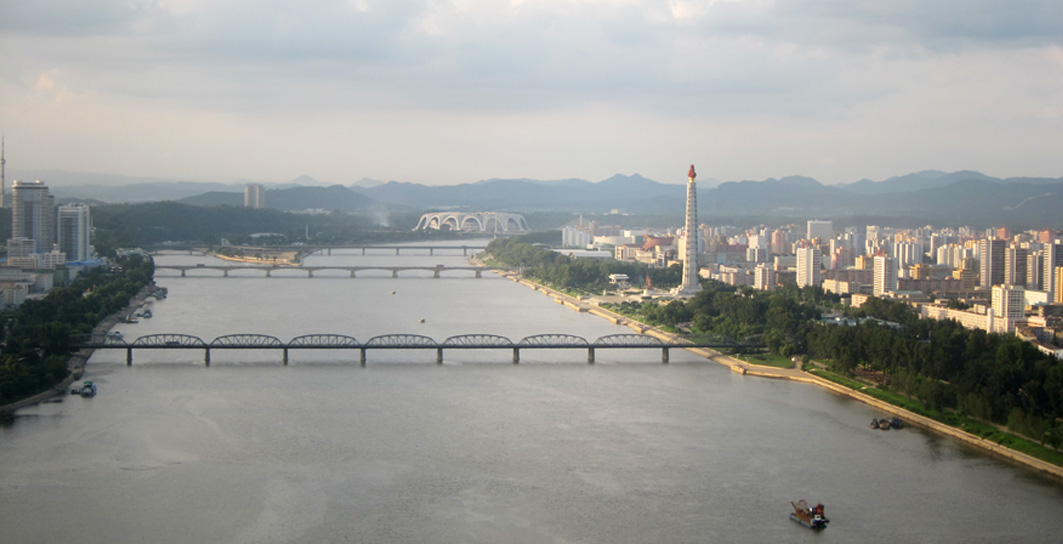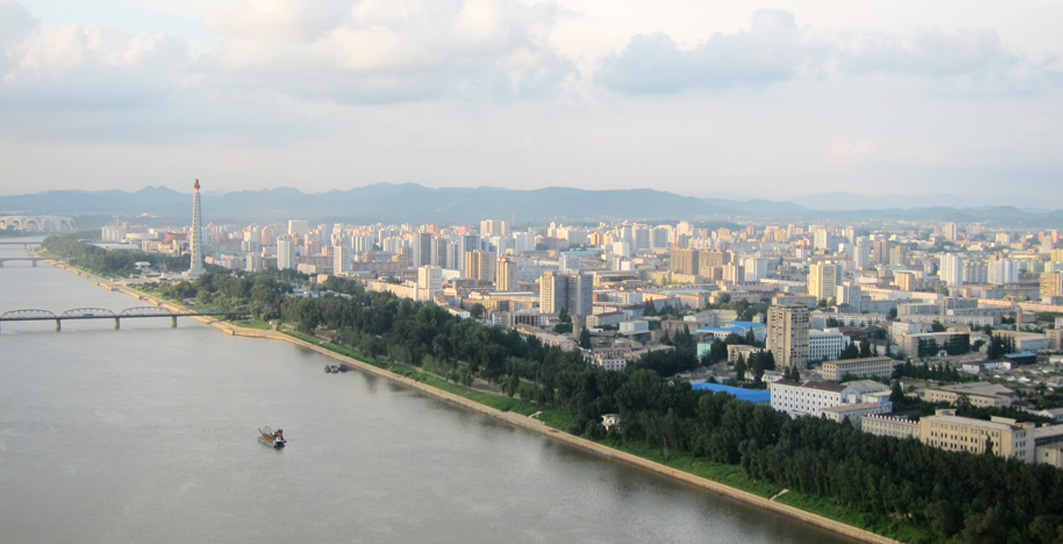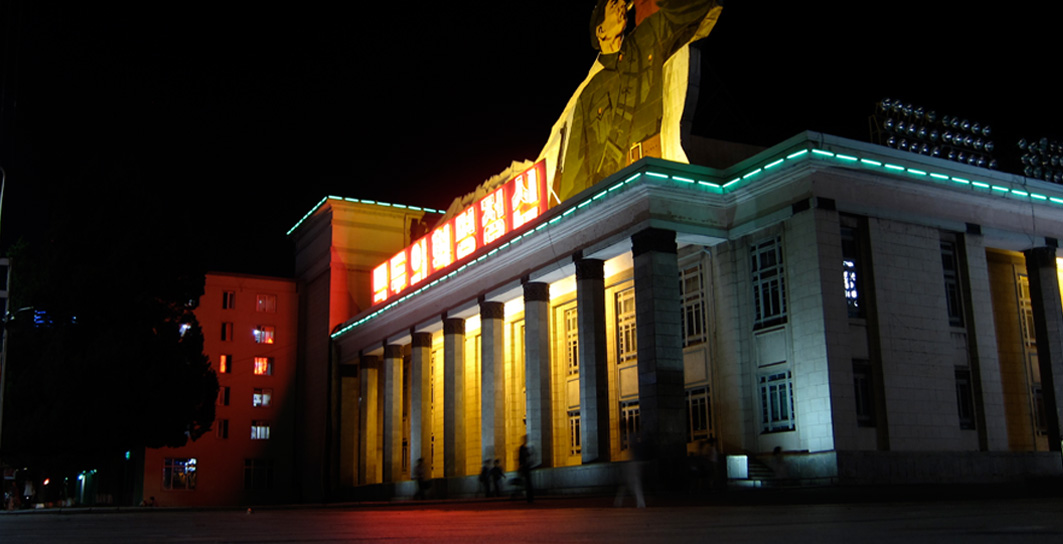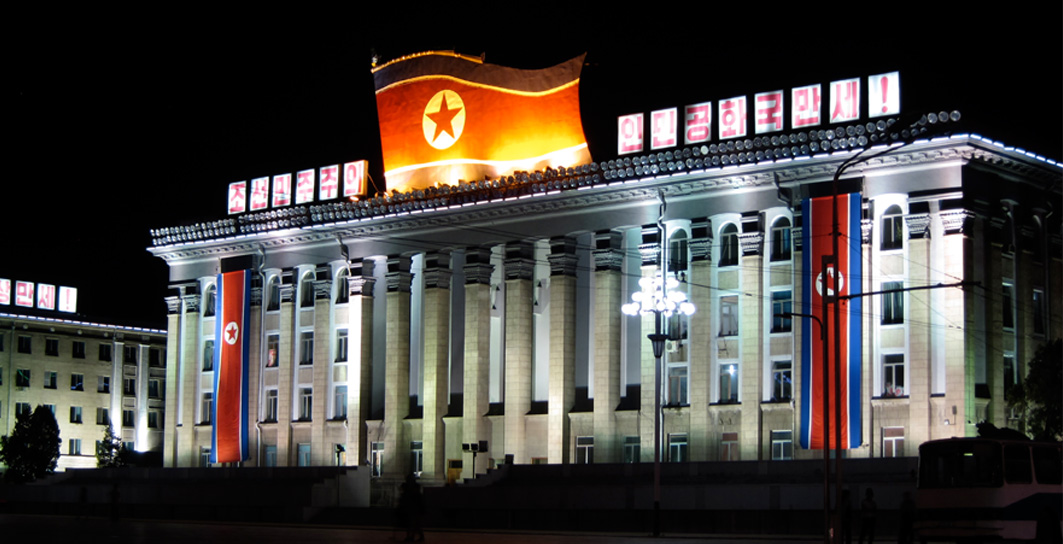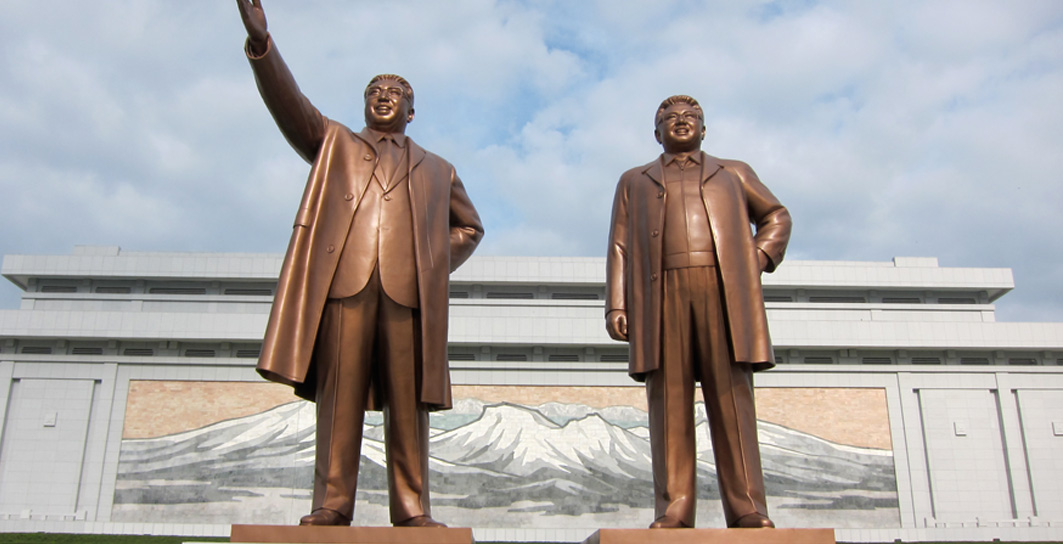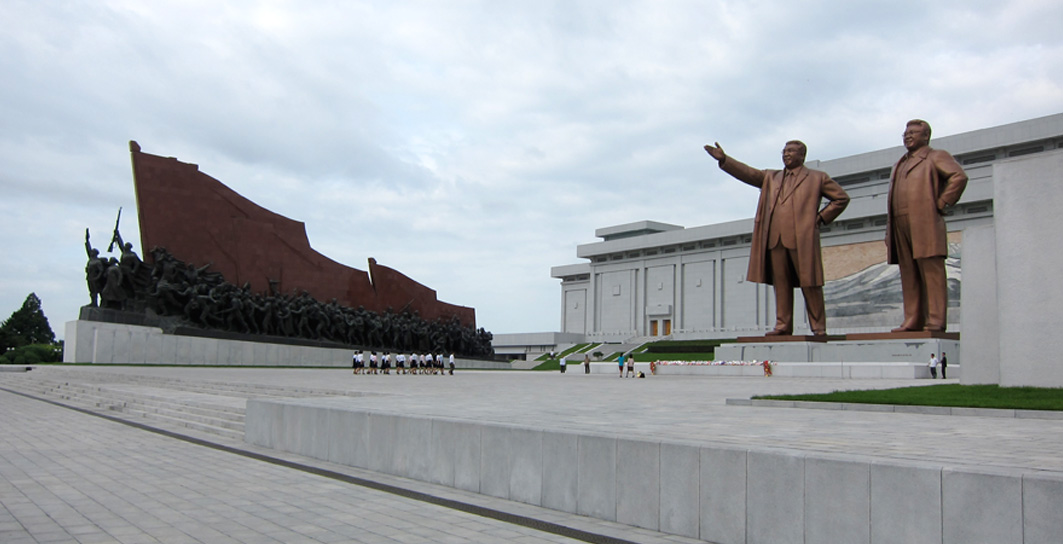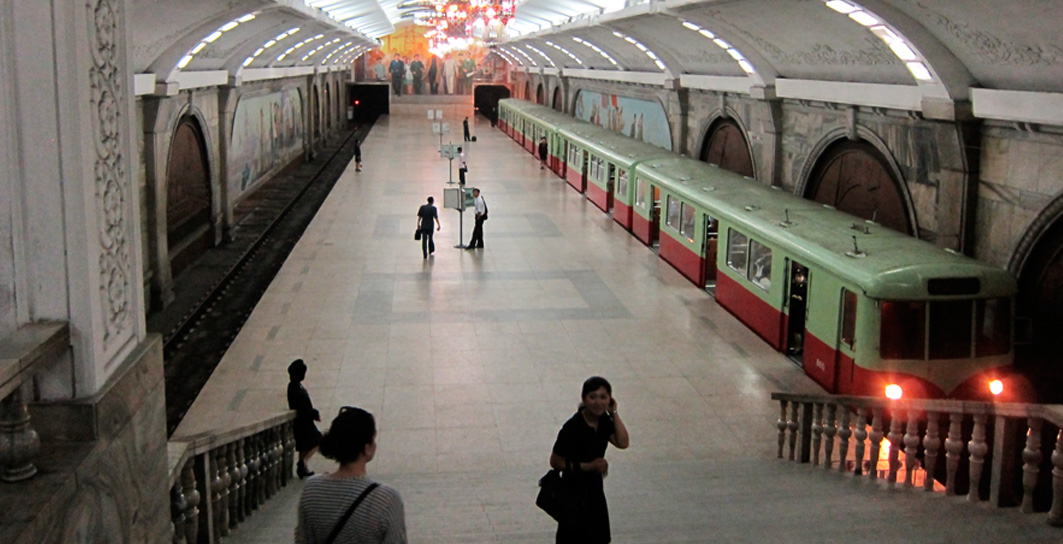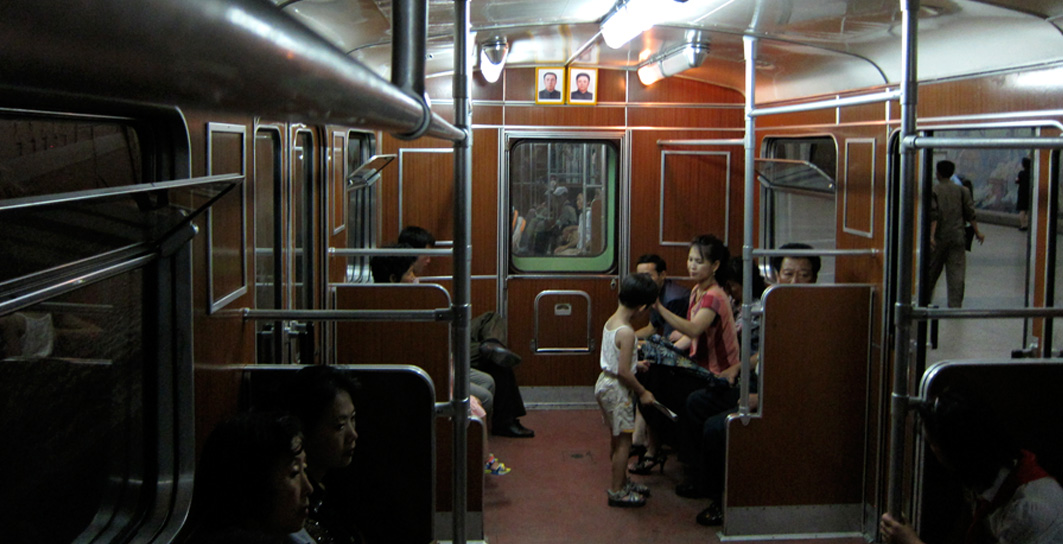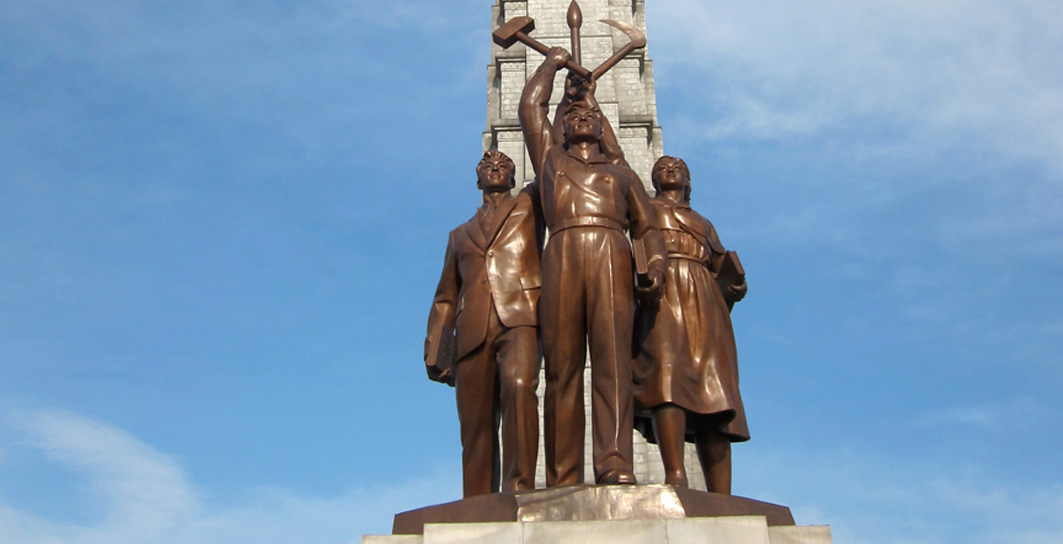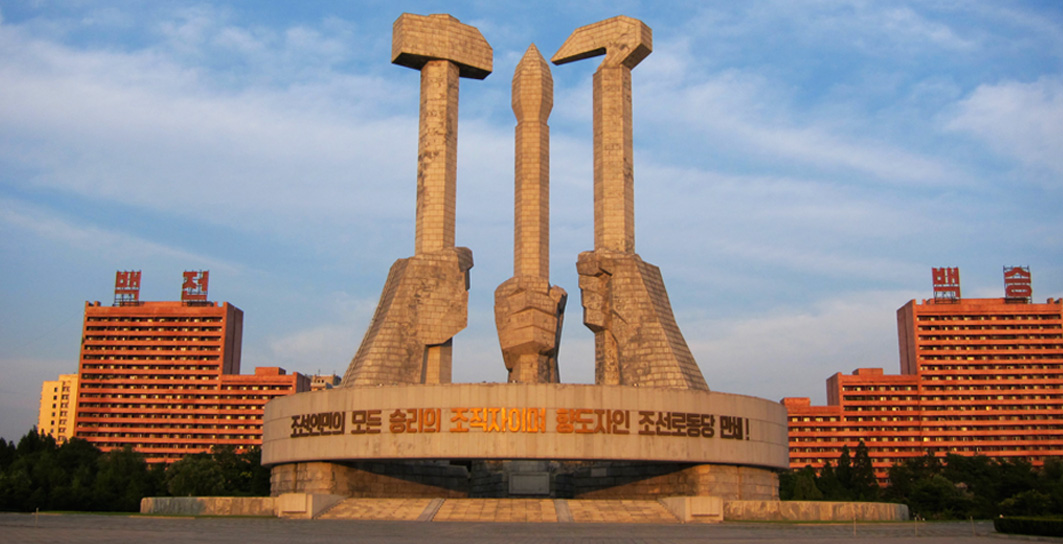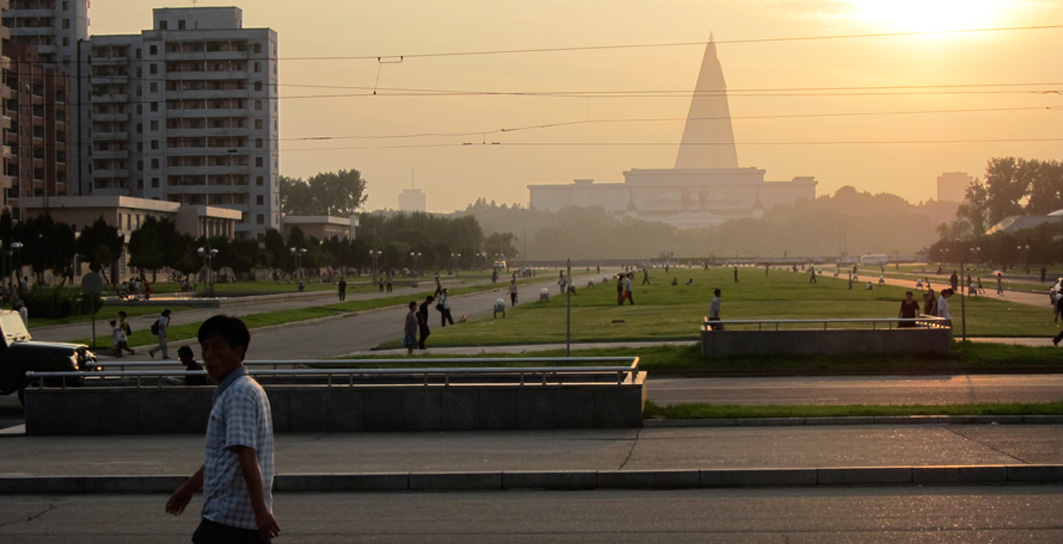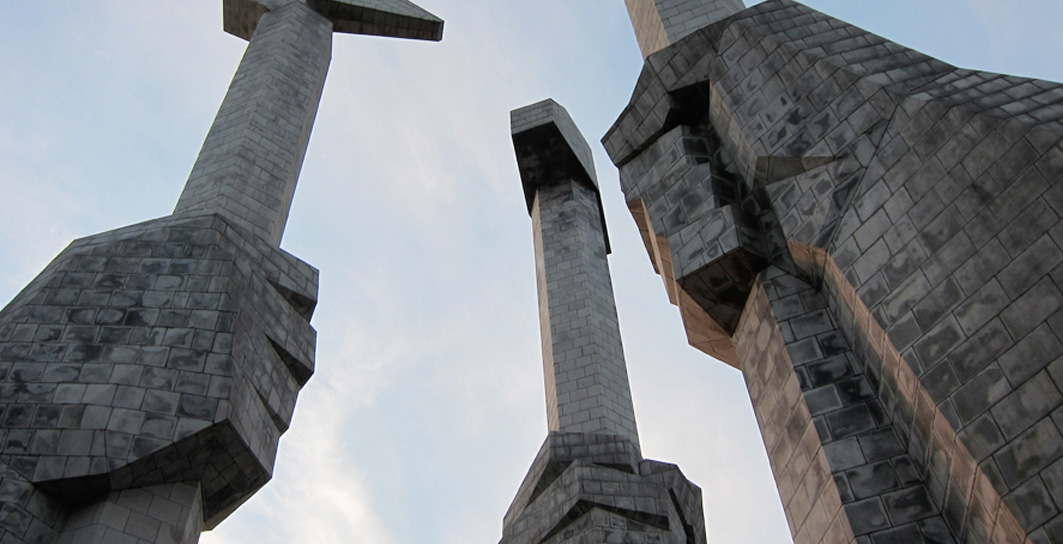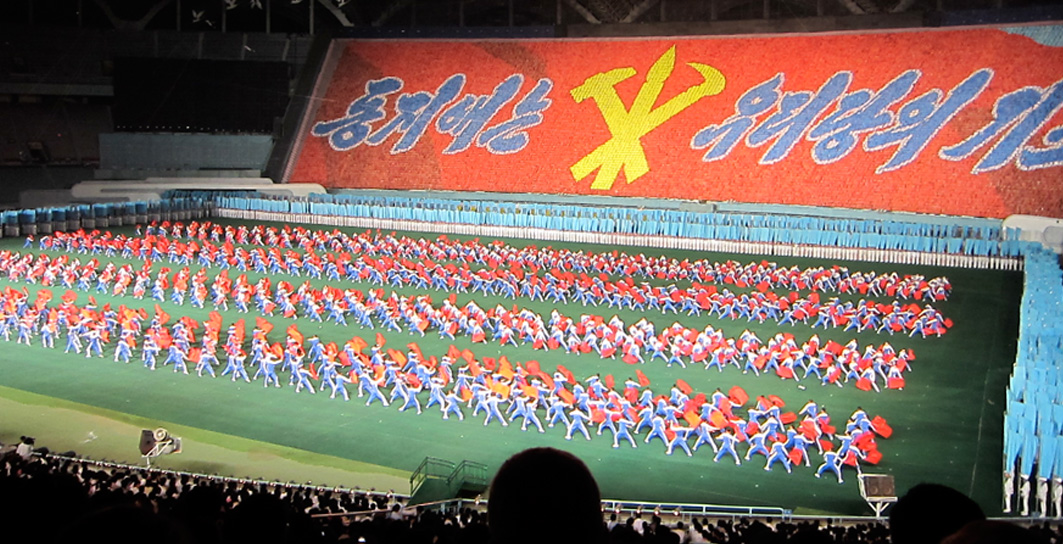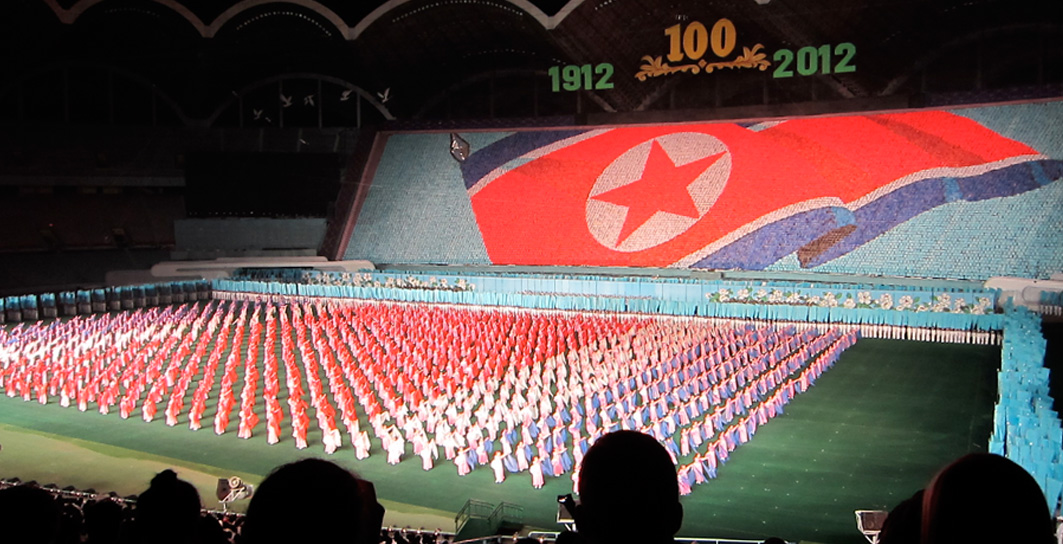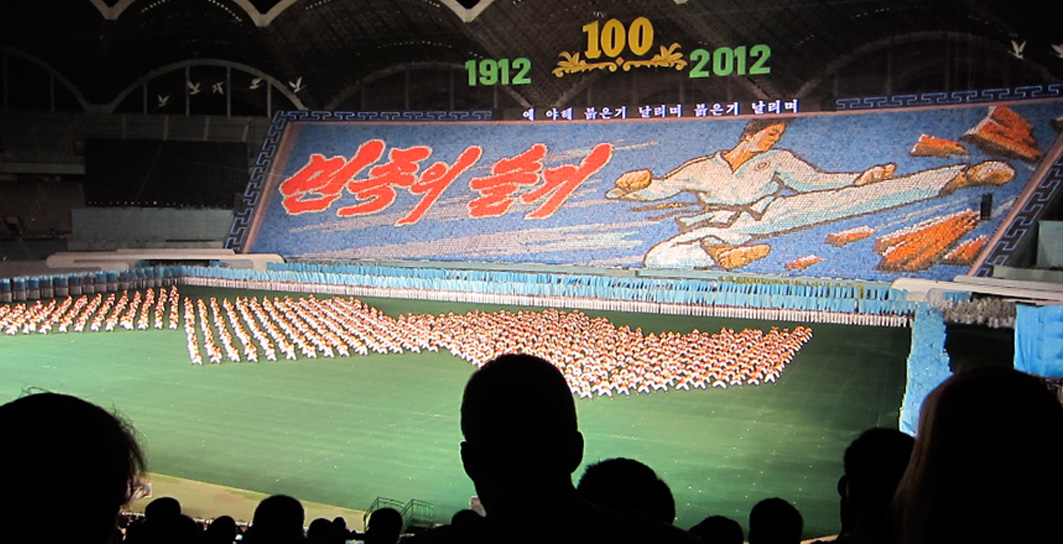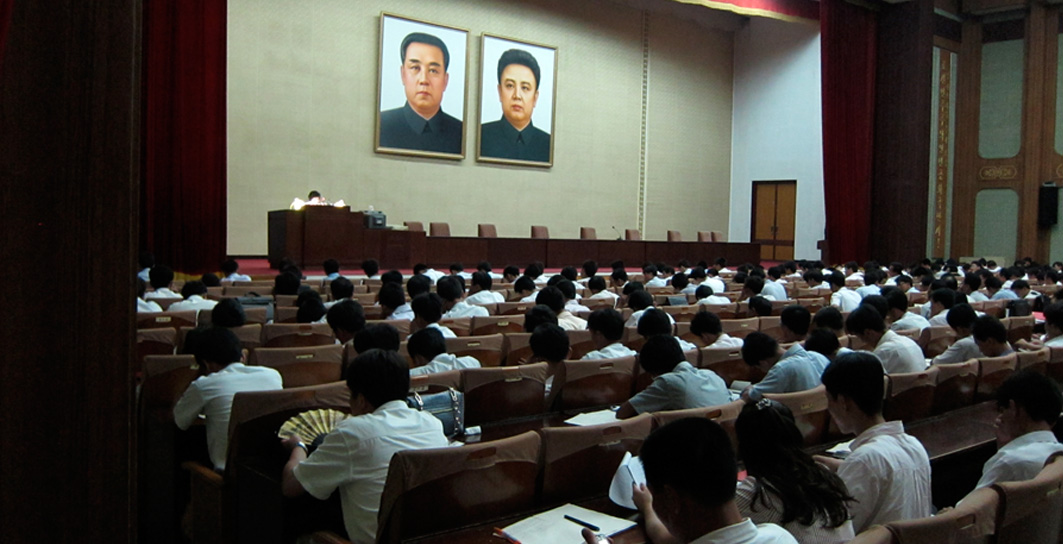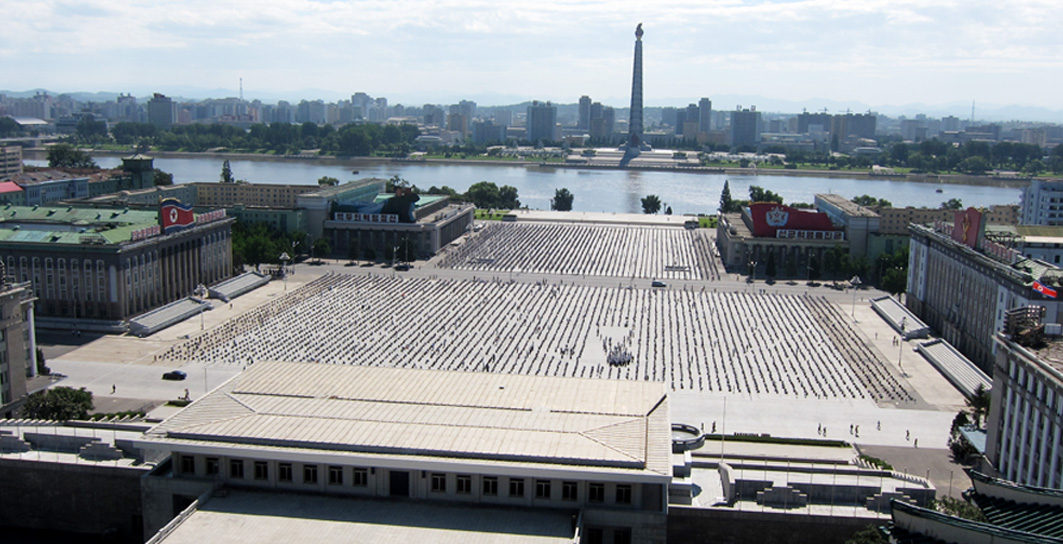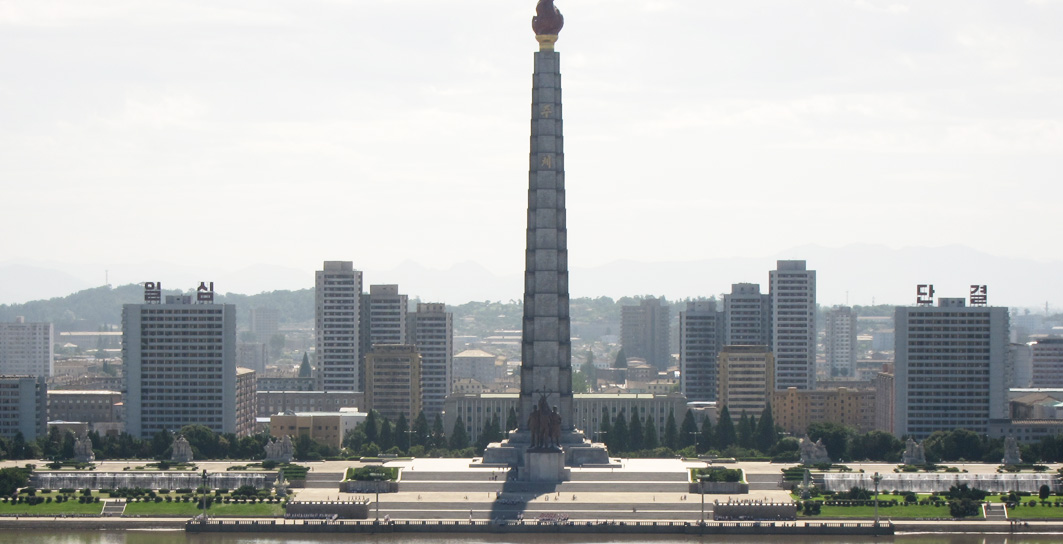Although almost every Backpacker is chasing after the place where things are different, he still just finds the same everywhere. North Korea is the place where things are really different. The only bad thing is that everybody thinks it’s impossible to go there. But as almost everything in the world even going to North Korea can be realised.
The first sight of Korea that I took were endless green rice fields between small hills, when I was looking out of the window of the Air Koryo plane that brought us from Beijing to Pyongyang. I had expected everything: smoking chimneys, military buildings, huge monuments or a brown war zone, but not those lovely green fields.
After landing at the airport, which was not much more than a big entrance hall with the prominent two portraits on the wall, we passed a not so tough security check as expected. We had to hand over our phones and were welcomed by our two guides and the driver who would be with us for the next 8 days. As it is impossible to travel in the DPRK on your own, you will always get two guides for your stay, even when you come alone.
On our 20 km ride from the airport to Pyongyang we were passing the fields I already had seen from the plane. Here and also on further rides trough rural Korea I saw, that North Koreans use every square inch they can get for planting, even if it’s just one row of corn at the end of a rice field.
Then suddenly: no suburbs, no nasty highway bridges, we entered Pyongyang and doing so we entered a new world. Marvelling out of the window I did not know, whether I am in a time machine or in a museum. There were no advertising signs but propaganda paintings, no McDonalds but monuments. Pyongyang also seemed to be almost too clean to be true. Not one little piece of paper was lying in the streets. Everything also seemed to be planned: no small houses, no wasted place, everything fits together and the roads are in perfect symmetry to the major buildings. Ten minutes later, facing an uniformed tourist guide in the war museum, we found out why: The U.S. Air force had dropped more bombs over North Korea in the Korean war than in the whole World War II altogether. As there were no buildings standing in Pyongyang any more, the city was completely planned and rebuilt as a communist masterpiece under the beginning era of Kim Il Sung.
After the war museum we were brought to the Yanggakdo hotel, one of the two places in Pyongyang where foreigners can stay. Located on a small island in the Taedong river, the Yanggakdo is right in the middle of the city and from our rooms in the 38th floor we could see the whole city and a lot of the places we would visit during the next few days.
We just arrived for the sunset, which threw the whole city into an amazing light. Looking at the Juche tower and listening to the military music coming out of the speakers distributed all over the city, I could have stayed at the window forever just to realize that I am in Pyongyang, the place which I would never have thought to reach!
After some amazing Korean food we were told that we would go to visit the brand new amusement park. So we got into our bus and drove through the nightly Pyongyang. For me this ride was better than any ride on a rollercoaster. To catch an eye of normal “nightlife” was way more interesting. What one would expect, out of what we are told in documentaries, would be dark and empty streets. But still, there were people walking on the streets and sitting and chatting at the corners and in the parks. Arriving in front of the amusement park, we realized, that it was totally dark and closed. Due to a holyday the day before – we were told. However, as it appeared that our guides were not too unhappy about us, we were able to make a spontaneous stop on our way back – which we found out later is a very rare thing in North Korea – at the Kim Il Sung square. Flashed with bright lights, the main square of Pyongyang lies at the river, fronting Juche tower on the opposite, and surrounded by huge communist-style buildings. This is the place, where the gigantic military parades take place, which scare the shit out of every western hard-line politician. Standing here in this peaceful, warm summer night was quite surreal.
The next morning started at 7am, as from now on every morning did. The North Koreans were very keen on showing us as much as possible. So we had a tight program every day. We started with a short walk and visited sight after sight. Highlights were the big bronze statues of the “great” leader Kim Il Sung and the “dear” leader Kim Jong Il, as well as the metro. 100 meters underground, Pyongyang has a fascinating Moscow style Subway. As most of the tourists can only visit the two extra glamorous marble stations, rumours say that there do not exist more stations. We stayed in the tube for five stations and they all looked quite real to me.
In the afternoon we drove from Pyongyang to Wonsan, a fisher city in the east of Korea by bus. The landscape on the ride was again green rice fields as far as you could see.
Arrived in Wonsan we went for a walk to a small island with a lighthouse on it. This walk turned out to become one of the best experiences we had in the DPRK. At the very ending of the road was a small viewpoint with some stone tables. At one of the tables five men were grilling shells and drinking soju-schnapps. Even though it’s not meant to get in closer contact to North Koreans than just saying hello, the place was simply too small, and both groups too curious about each other to prevent getting in touch. So pretty soon some of us were sitting at the table with them and tried the shells and the soju-schnapps they offered us. Our guides were not really pleased with the situation, but as it was on an island and no one was watching us and the atmosphere was really good, they surrendered and started to interpret and enjoyed the scene too. It turned out, that the men were musicians and so we ended singing Korean and Swiss songs to each other. On our way back to the mainland quite a few felt the soju in their knees.
Small moments like these make your travelling, even in such a restricted place like North Korea, so much worth it. Moments, in which you learn more about a country and its people, than by watching hundreds of documentaries.
In the next morning we visited an agricultural university, which was close to Wonsan. The whole visit told us a hundred times more about how things are in North Korea than it did about agriculture. They didn’t show anything that a western visitor would expect. Instead we were told when the great leader Kim Il Sung visited the university, which hints he gave, where he was standing and what big impact all these things had on the university. It was maybe a nonsense visit for agriculture but we started to understand that really everything in North Korea is based on eternal president Kim Il Sung, who died in 1994.
After this visit we crossed from the east to the west coast and headed to the West Sea Barrage, a great dam close to Nampo. Before visiting the dam itself we stopped at a small beach and went for a swim. Again, this was amazing not because of the beach but because of all the North Koreans who were there too. They were swimming, playing ball and dancing to music. When I asked our guide who they were and how they came here, he explained, that they all come in groups like work units, school classes or groups of soldiers which have their day off. Back at the dam we saw in a movie (http://www.youtube.com/watch?v=VHu5FEeIqfM), how North Koreans have built the dam in the 80’s. The dam is 8km long and as it doesn’t seem to be any military building or huge monument just to impress the rest of the world, it probably really made North Korean’s life better as they say in the movie. The dam protects the whole backcountry up to Pyongyang from floods and keeps the saltwater away so it guarantees drinking water for people as well as water to irrigate the fields. It is definitely the civil use and the proudness of the Korean people that made this dam so impressive to me. From now on I saw pictures of the dam everywhere and realized that people all over the country are proud of it, even though, they may never have seen it with their own eyes.
Next day we headed down south to Kaesong so we could go to the DMZ (demilitarised zone), the well-known border between North and South Korea. Before going on the five hours bus trip, we stopped again in Pyongyang and visited the birthplace of Kim Il Sung. It’s one of the most holy places for North Koreans, so they try to make a pilgrimage there at least once in their lifetime. It was not surprising how many people we saw there. Just after us a football team of little boys came and when we walked back, we saw thousands of people heading to the place as well.
In the late afternoon we visited the national circus. Circuses are impressive most of the times, but this circus gave you the extra adrenalin of being in North Korea. The fact of sitting next to soldiers and the whole infrastructure and scenery provided a great show for itself.
After the show we got into our bus and drove southwards into the night. The deeper south we got, the more we realized, where we actually were heading to. Everybody thinks of this frontier between north and south as the last hot spot of the cold war, as one of the world’s most dangerous places. I have to admit, that I had totally forgotten about it during the past days when I actually was in North Korea. Even though we saw military people all over I didn’t recognise them as soldiers but more as the normal way how men were dressed here. Also none of them was armed. So it was quite a strange feeling when our bus got into the first checkpoint with “real” soldiers now. The deeper south we were going, the more checkpoints appeared. I also noticed all those huge monument blocks on both sides of the road. I have read in advance that they, in case of war, would be blown up, so they would fall into the street and block it for tanks.
Next morning at the DMZ even those real soldiers looked quite human to me. We got a young officer as a tourist guide and two soldiers for protection. I even saw the officer making fun with the two soldiers when he felt unobserved. So the whole frontier wasn’t half as scaring or exciting as expected. I think this only applies when you are standing on the South Korean side, watching over to the axes of evil and imaging how bad things must be over there. But when you are actually standing on the other side and see those soldiers’ faces and see those normal people living quite normal lives, then the whole scenery turns into some huts and a thin line which divided a nation thad had the bad luck of being at the wrong place at the wrong time in world history.
In the afternoon on our way back to Pyongyang we visited one of the 4000 cooperations, which manages all the rural businesses of the country and where all North Korean farmers work at. The whole scenery looked huge and I just want to give a short list of key numbers to those of you who have an idea of rural business: 1800 people, of which 1000 are farmers, organized in 10 brigades, working on 900 Hectares, of which 800 are planted with rice. The annual average earning of rice was told to be 10 tons a hectare.
In the evening of this first of august we would go out and watch the premiere of the Arirang Mass games. 100’000 people performing a show in the biggest football stadium of the world sounded quite good. Before going there we had time to visit the Juche Tower. The huge, 70 meters high tower was built for Kim Il Sung’s 70th birthday (every meter stands for one year). The tower with its red, animated flame on top is a symbol for the North Korean philosophy called juche, founded by Kim Il Sung. Main goal of Juche is autarky and that men are the masters of their own destiny. In real life this is shown by the peoples will to struggle and work even harder in though times, of which they are facing enough.
As there was still time after eating dinner we also visited the workers party monument. This was one of the places I wanted to visit most of all in North Korea. I saw it once on Google Earth a long time before I even knew that going to North Korea could become possible for me and I thought how crazy and amazing it had to be there if they’re building such huge and massive monuments. To see it in person was very impressive. Three huge cement fists are holding hammer, sickle and a brush on top of a huge circle. Even the apartment blocks in the back are designed in the figure of red flags waving on both sides. In front of it was again a perfect example of the city planning. After a 2km long park, which formed a straight line, there was the Mansu hill with the two big bronze statues and behind them, in the perfect middle was the huge Pyongyang pyramid. Still this was just the beginning of tonight’s astonishment. While driving to the first of may stadium we saw thousands of people, coming from all directions, walking there as well. Some of them in costumes, as participants, others in army uniforms or whole working units, as visitors. In front of the stadium ten thousands of people met and waited to go inside. Walking through this electrified mass was like how it must have been walking into the coliseum in ancient Rome.
The first thing we noticed while walking into the stadium and taking our seats was the huge wall of people on the opposite tribune. We counted over 50’000 people holding up the coloured pages of books to create huge background pictures. These images combined with a mass gymnastic performance in front of it were the Arirang mass games. Our guide had already told us before the story of Arirang. Arirang is actually nothing else than a Korean version of Romeo and Juliet. The mass games combined the Arirang story with the history of the DPRK. It was absolutely spectacular. Artists were flying 100 meters through the air into nets, hundreds of Taekwon-do black belts were performing kicks and hyeongs and the background pics turned better and more difficult with every new image.
Sitting in the bus on our way back I already felt like going to bed after a great night when suddenly our guide asked us whether we are tired or if we wanted to visit the amusement park tonight. Of course we wanted. This time the park looked absolutely the opposite of our first try. Everything was alighted and it was completely crowded. Thousands of people and they all seemed to have real fun there. Whenever we got on a rollercoaster we left some space between us, so we were all sitting next to North Koreans which gave small but funny chats facing a wild ride or a deep abyss. When we left after midnight the park was still full of people.
The next day was already our last day before departure. I had absolutely lost every feeling for days during this stay. Having no phone, no newspaper and no contact to the outside makes it pretty easy to forget which day it is. First point of today’s program was the “great people’s palace of studies”. The main building at the Kim Il sung square is a free university for everybody. All people have a certain amount of days they can get off their working unit to come here and study. There are lectures in all kinds of subjects and a public library with over 30 million books. We could check the library catalogue on the computer and even found Swiss books and also an audiocassette with Swiss folksongs. When we visited the palace all classrooms were full of people studying. On the top floor we could step out to the balcony, which faced the Kim Il Sung square. Thousands of people were training on the square for the mass games so it felt a little bit like watching a military parade. Before lunch we also visited the Pyongyang zoo. Interesting was that next to all the normal zoo animals, who mostly were gifts from dictators/presidents from all around the world, they exhibited also a whole collection of European dogs. So a little pug was presented like a tiger.
In the afternoon we visited the national art museum that holds more important old Korean art as whole South Korea together as well as of course modern, photorealistic paintings of Kim Il Sung and Kim Jong Il. Last point of the program was a visit at a primary school plus a music performance by very talented but also very drilled kids.
After our last breakfast we drove to the train station where we got onto a train that brought us to the Chinese border. It actually was an old Swiss train coach. As the train left the station and we drove out of Pyongyang hundreds of people, who were working or cleaning the rails, were waving to us. Of course they just waved because there was always someone on the train waving at them but as it got on like this for hours it really turned into another surrealistic episode of this curious and so amazing trip.
My Journey to the democratic peoples republic of Korea happened in Summer 2012 and was organised as a trip for Swiss students by encounterkorea, based in Hong Kong. That we have been to North Korea as students and not as tourists has opened us many doors and gave us the possibility to get to know the country much deeper than others. Still of course the trip was very restrictive. We weren’t allowed to walk around by ourselfs or just stay somewhere if we liked it. Nevertheless it was such an amazing experience that I would recommend you even to do the most stupid tourist tour you can get, because even just being in Pyongyang is such an adventure.
Check out www.encounterkorea.com to see if there is maybe a tour for you…
